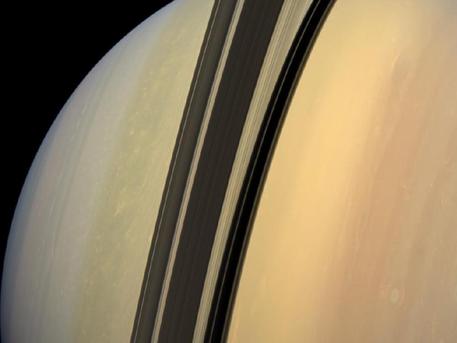Fascinating picture of Saturn
Fun facts about Saturn
 © NASA
|
This mosaic combines 6 images--2 each of red, green and blue spectral filters--to create this natural color view. The images were obtained with the Cassini spacecraft wide-angle camera at a distance of approximately 750,000 miles from Saturn.
The planet is named after Saturn, the Roman god of agriculture. The day Saturday is also named after him.
Saturn is huge. It is the second largest planet in our Solar System. Only Jupiter is bigger. If you could line them up, more than nine Earths would fit across Saturn.
Unlike Earth, Saturn is made mostly of hydrogen and helium. While it has heavier materials in the core, Saturn has no surface on which you could stand.
Its beautiful rings are not solid either. They are made up of particles of ice, dust and rock.
Round Orange Bullet Some of these particles are as tiny as grains of sand, some are much larger than skyscrapers. Actually, some are up to half-a-mile across.
The rings are huge yet tiny: the main rings could cover almost the entire distance between Earth and the moon yet they are about half-a-mile thick.
We now know that other planets have rings, but Saturn's are the only ones that are visible from Earth even with a small telescope.
Because Saturn is tilted, when its rings are facing Earth edge on they "disappear" from our view. We now know this happens every 14 years or so, but poor Galileo questioned his sanity when they "disappeared" and then "reappeared" on him a few years later.
It's pretty windy on Saturn. Winds around the planet's equator can reach 1,118 miles per hour. In comparison, the fastest winds on Earth "only" reach about 250 miles per hour.
Saturn goes around the Sun very slowly, but spins on its axis extremely fast. A Saturn year lasts for more than 29 Earth years, but a Saturn day only lasts 10 hours and 14 minutes.
Because of this rapid spin and its low-density interior, Saturn is noticeably flattened, top and bottom. Saturn is 10 percent fatter in the middle than at the poles.
Saturn is the only planet in our Solar System that is less dense than water. Which means that if you could build a ridiculously large bathtub, Saturn would actually float in it.
Its density is only 0.13 that of Earth.
The Ringed Planet is so far away from the Sun that it receives only about 1/80th the amount of sunlight that we do here on Earth and so the Sun also appears much smaller from there.
NASA
Fascinating picture of Saturn
Fun facts about Saturn
 © NASA
|
This mosaic combines 6 images--2 each of red, green and blue spectral filters--to create this natural color view. The images were obtained with the Cassini spacecraft wide-angle camera at a distance of approximately 750,000 miles from Saturn.
The planet is named after Saturn, the Roman god of agriculture. The day Saturday is also named after him.
Saturn is huge. It is the second largest planet in our Solar System. Only Jupiter is bigger. If you could line them up, more than nine Earths would fit across Saturn.
Unlike Earth, Saturn is made mostly of hydrogen and helium. While it has heavier materials in the core, Saturn has no surface on which you could stand.
Its beautiful rings are not solid either. They are made up of particles of ice, dust and rock.
Round Orange Bullet Some of these particles are as tiny as grains of sand, some are much larger than skyscrapers. Actually, some are up to half-a-mile across.
The rings are huge yet tiny: the main rings could cover almost the entire distance between Earth and the moon yet they are about half-a-mile thick.
We now know that other planets have rings, but Saturn's are the only ones that are visible from Earth even with a small telescope.
Because Saturn is tilted, when its rings are facing Earth edge on they "disappear" from our view. We now know this happens every 14 years or so, but poor Galileo questioned his sanity when they "disappeared" and then "reappeared" on him a few years later.
It's pretty windy on Saturn. Winds around the planet's equator can reach 1,118 miles per hour. In comparison, the fastest winds on Earth "only" reach about 250 miles per hour.
Saturn goes around the Sun very slowly, but spins on its axis extremely fast. A Saturn year lasts for more than 29 Earth years, but a Saturn day only lasts 10 hours and 14 minutes.
Because of this rapid spin and its low-density interior, Saturn is noticeably flattened, top and bottom. Saturn is 10 percent fatter in the middle than at the poles.
Saturn is the only planet in our Solar System that is less dense than water. Which means that if you could build a ridiculously large bathtub, Saturn would actually float in it.
Its density is only 0.13 that of Earth.
The Ringed Planet is so far away from the Sun that it receives only about 1/80th the amount of sunlight that we do here on Earth and so the Sun also appears much smaller from there.
NASA






